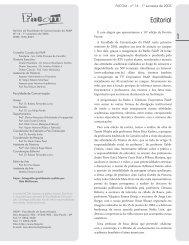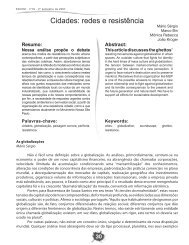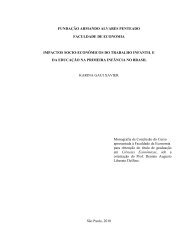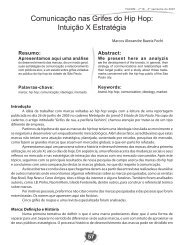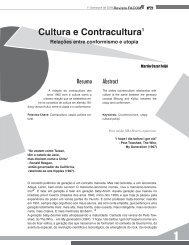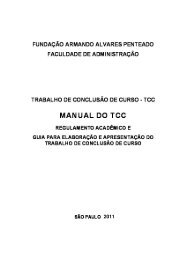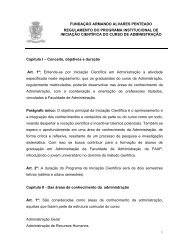Número 8 - Janeiro 2006 - Faap
Número 8 - Janeiro 2006 - Faap
Número 8 - Janeiro 2006 - Faap
You also want an ePaper? Increase the reach of your titles
YUMPU automatically turns print PDFs into web optimized ePapers that Google loves.
In doing so, we must start from the current state of the Doha Round<br />
which, after the false start ended so ignominiously at Cancun, now finds itself in<br />
a curious stage that resembles the “Phony War” at the beginning of World War<br />
II. Waiting for a new WTO Director-General to be selected in the next few<br />
weeks, no true negotiations are taking place to prepare for the Hong Kong<br />
Ministerial Conference at the end of this year. There is therefore no concrete<br />
basis for an informed conjecture about whether that Conference will succeed in<br />
paving the way towards a successful conclusion of the Round someday in <strong>2006</strong>,<br />
before the US Trade Promotion Authority expires the following year or a new<br />
American farm bill further complicates the negotiations.<br />
We are thus reduced to trying to figure out the shape of the future trading<br />
system without any assurance that the present one will survive the current test.<br />
About 15 years ago, in 1990, the year that the Uruguay Round talks were<br />
supposed to conclude but instead collapsed in Brussels, the situation closely<br />
resembled in some respects what we are experiencing today. I remember the era<br />
well, because I was then the Chairman of the GATT Council, waiting to become<br />
the Chairman of the Contracting Parties the following year. A long and tedious<br />
crossing of the desert lay before us until a breakthrough was achieved in 1993.<br />
During that period, much effort was spent in trying to visualize what would<br />
likely be “The world trading system after the Uruguay Round”, the title of the<br />
best essay on the subject, written by Robert Z. Lawrence and Robert E. Litan<br />
and published by the Boston University International Law Journal, 8 (Fall 1990).<br />
Four main scenarios were outlined by the authors as the most probable outcome<br />
of that Round, but they apply equally to the current stalemate if we replace the<br />
word GATT with WTO: the continuation of a GATT-based regime; the development<br />
of a world of trade blocs; the transition towards a managed trading system and,<br />
finally, the emergence of a GATT-plus system. The pre-condition for the existence<br />
of the first scenario was the successful conclusion of the Round. In that case, the<br />
GATT/WTO would continue to play an important but declining role because it<br />
was confined to the traditional “border measures” -— that is, tariffs, antidumping,<br />
countervailing duties, etc. The spirit of the times allegedly required “deeper<br />
integration” in the form of harmonization of domestic legislation and national<br />
standards in sensitive areas hitherto reserved to countries’ sovereignty. For that<br />
reason, according to the article, an organization like the Gatt/WTO, with a<br />
membership of over 100 countries (they now number 150), at very different stages<br />
of economic development, would not be adequate to reach consensus on a significant<br />
number of questions within a reasonable time limit.<br />
The study asserted that it would be more efficient to advance towards<br />
global integration through a process that would first establish regional<br />
“building blocks” to be connected subsequently to form a more open global<br />
integrated unity. It admitted that if the Round failed, the blocs might<br />
become closed to third parties and, instead of “building blocks”, they might<br />
evolve into “stumbling blocks”. In that event, the blocs could not only<br />
frustrate the goal of “deep integration” but might lead to the fragmentation<br />
of the 1930s, a remote hypothesis for the authors.<br />
Trade challenges in globalizing imbalanced world, Rubens Ricupero, p. 84 - 96<br />
93






